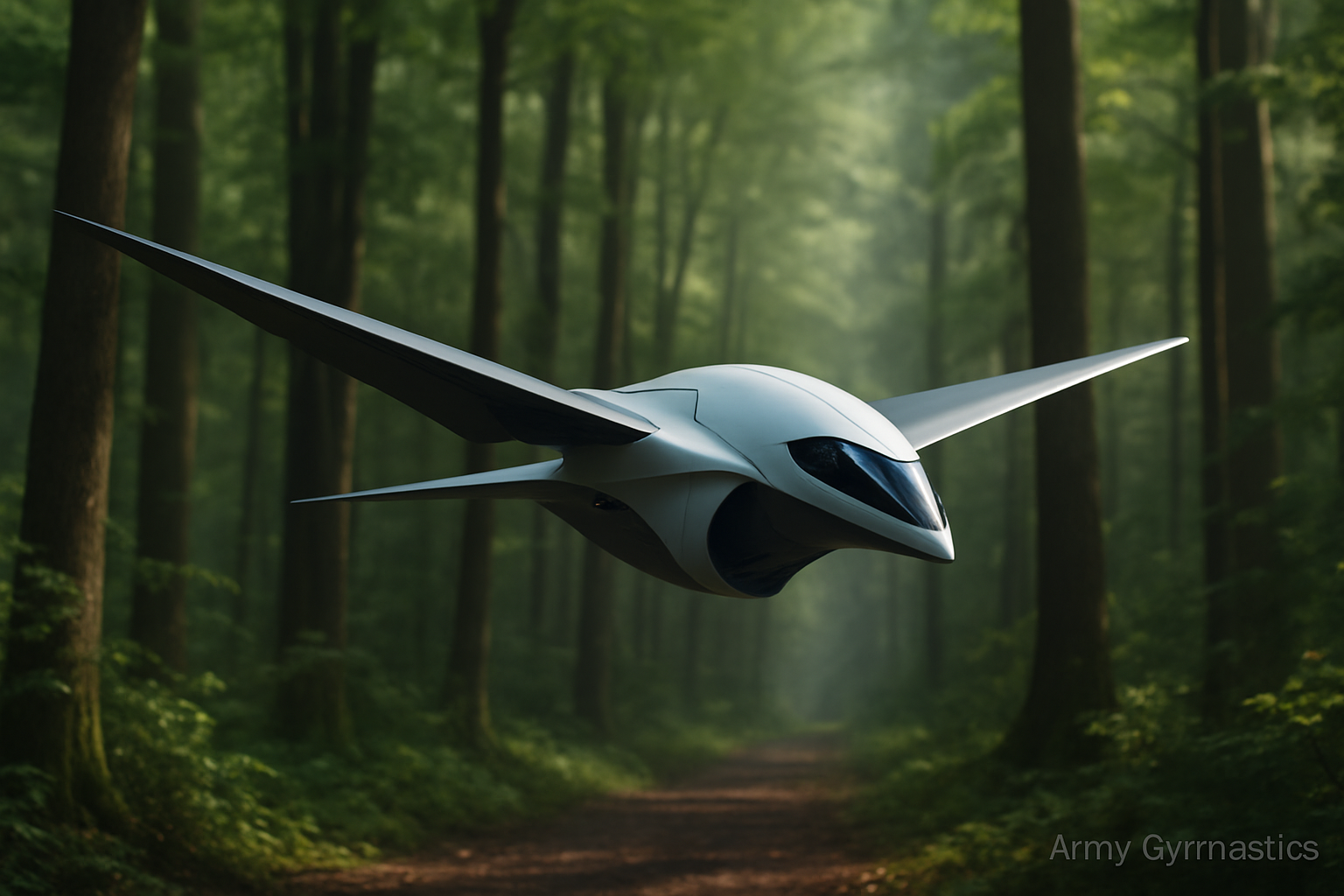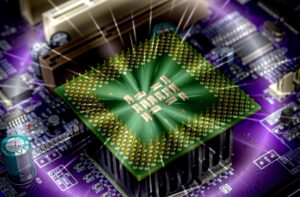I. Introduction: Beyond Human Limits – The Rise of Autonomous “Robot Birds”
The landscape of aerial technology is undergoing a profound transformation, moving beyond conventional piloted aircraft and remotely controlled drones towards a future defined by true autonomy. The aspiration is to develop aerial vehicles that can operate independently, mirroring the remarkable agility, speed, and adaptability of natural flyers, even in the most challenging and unknown environments. This vision extends far beyond simple pre-programmed flight paths, aiming for systems capable of real-time decision-making and dynamic obstacle avoidance where traditional navigation methods falter.
A significant leap towards this future has recently emerged from the University of Hong Kong (HKU). Researchers have unveiled the Safety-Assured High-Speed Aerial Robot (SUPER), colloquially termed a “robot bird.” This groundbreaking development is poised to redefine drone technology, enabling autonomous navigation through dense, complex environments at high speeds without any reliance on GPS signals or external light sources. Experts describe this innovation as a “game-changer,” highlighting its ability to imbue drones with bird-like reflexes for instantaneous obstacle avoidance and rapid decision-making in dynamic settings.
This report will delve into the intricate technologies that power SUPER’s unprecedented autonomous capabilities, examining the engineering marvels that allow it to perceive and navigate the unseen. Subsequently, the discussion will pivot to explore parallel advancements in sustainable aviation propulsion—specifically, the emergence of sodium-air and hydrogen fuel cells. These next-generation energy solutions are poised to address the critical energy density challenges that currently limit electric flight, fundamentally transforming the broader aerospace industry. The ultimate vision is a symbiotic future where flight is not only autonomously controlled but also environmentally responsible, heralding a new era of aerial mobility.
II. Navigating the Unseen: The SUPER Drone’s Breakthrough Technology
A. The Uncharted Territory: Challenges of Autonomous Flight in Complex Environments
Traditional drone operations are inherently constrained by their reliance on external guidance systems, primarily Global Positioning System (GPS) for localization and pre-mapped routes for navigation. This dependency renders them vulnerable in environments where GPS signals are degraded, jammed, or entirely unavailable, such as urban canyons, deep forests, or subterranean spaces. Furthermore, conventional camera sensors, often central to drone navigation, struggle significantly in low-light conditions, complete darkness, or scenarios with high dynamic range, leading to motion blur and hindering accurate environmental perception. These limitations severely restrict their operational hours and utility in critical, time-sensitive scenarios.
The challenges are compounded when considering dense, dynamic environments like forests, collapsed buildings, or disaster zones. Such settings present an unpredictable labyrinth of thin obstacles, including branches and wires as fine as 2.5 millimeters, which traditional drones perceive as impassable barriers. Navigating these cluttered spaces demands extreme agility, rapid processing, and instantaneous decision-making capabilities that current systems often lack. Moreover, these environments frequently lack reliable GPS signals and can experience rapidly changing illumination conditions, exacerbating the already formidable navigation hurdles.
The development of the SUPER drone represents a fundamental shift in the design philosophy for autonomous aerial systems. Unlike traditional drones that operate on a top-down, planned approach, often relying on pre-programmed routes or external mapping, SUPER is engineered to emulate the innate speed and agility of birds navigating unknown, cluttered environments. Professor Fu Zhang, a lead researcher, explicitly states that the system is “like giving the drone the reflexes of a bird”. This is not merely an incremental improvement in processing speed; it signifies a move from static, pre-programmed guidance to a bio-inspired, reactive, and adaptive form of autonomy. This paradigm allows for genuine exploration and operation in dynamic, unmapped spaces, fundamentally expanding drone utility beyond controlled or pre-surveyed environments. It suggests a progression towards embodied intelligence, where the drone’s understanding of its surroundings is continuously updated and acted upon in real-time, rather than depending on a fixed internal map. This capability is crucial for unlocking applications in truly complex and unpredictable real-world scenarios.
B. Engineering Avian Intelligence: The Mechanics of SUPER
The core of SUPER’s breakthrough lies in its sophisticated integration of advanced hardware and intelligent software. At the heart of its perception system is a lightweight 3D Light Detection and Ranging (LIDAR) sensor. This sensor is capable of detecting obstacles up to an impressive 70 meters away with pinpoint accuracy, providing the long-range, high-precision spatial awareness critical for high-speed navigation and early obstacle detection.
For high-speed, obstacle-rich, and light-constrained environments, LIDAR provides a more robust and reliable perception backbone than traditional visual sensors. While event cameras are also recognized for their superior performance in low-light and high-dynamic-range scenarios, SUPER’s specific reliance on LIDAR for obstacle detection and mapping allows it to generate detailed point clouds of its surroundings. This capability enables the necessary real-time spatial awareness that GPS cannot provide, particularly in environments where satellite signals are absent or unreliable. The system’s ability to process this LIDAR data directly as point clouds significantly reduces computation time, facilitating rapid decision-making crucial for navigating at high velocities.
SUPER’s intelligence is further enhanced by an advanced planning framework that generates two simultaneous trajectories during flight. One trajectory is optimized for speed, allowing the drone to venture into unknown spaces and cover ground efficiently. Concurrently, a second trajectory prioritizes safety, ensuring the drone can remain within known, obstacle-free zones if immediate threats are detected or uncertainty is high. This dynamic balancing act allows for both operational efficiency and proactive risk mitigation. The emphasis on “safety-assured” in the drone’s full name is not merely a technical feature; it represents a strategic design philosophy that directly addresses a major barrier to widespread drone adoption: public and regulatory trust. By building safety into the core planning algorithms—prioritizing obstacle-free zones and generating alternative safe paths—SUPER aims to overcome the inherent risks associated with high-speed autonomous operation. This proactive safety integration is critical for commercial viability, regulatory approval, and societal acceptance, especially for applications like delivery or search and rescue where human interaction or proximity is involved. It suggests that future autonomous systems will increasingly be judged not just on their raw capabilities, but on their demonstrable and inherent safety mechanisms.
The seamless synergy between the drone’s compact physical design (with a wheelbase of just 280 mm and a takeoff weight of 1.5 kg) and its sophisticated algorithms allows for exceptional agility and robustness. This integrated approach enables SUPER to navigate dense forests at night and skillfully avoid thin wires, demonstrating a level of safety and autonomy previously unattainable in such challenging conditions.
Table 1: SUPER Drone Key Technical Specifications
| Feature | Specification | Notes |
| Speed | Exceeds 20 meters per second (45 mph / 70 KPH) | Enables rapid navigation in complex environments |
| Wheelbase | 280 mm | Compact design for agility in tight spaces |
| Takeoff Weight | 1.5 kg | Lightweight for enhanced maneuverability |
| Obstacle Avoidance Thickness | As thin as 2.5 mm | Capable of avoiding power lines, twigs, etc. |
| LIDAR Detection Range | Up to 70 meters | Pinpoint accuracy for early obstacle detection |
| Navigation Method | Onboard 3D LIDAR, advanced planning framework, real-time point cloud processing | Operates without GPS or external light |
C. A Game-Changer: Real-World Applications and Implications
The capabilities of the SUPER drone technology open up a wide array of transformative real-world applications across various sectors. Its ability to navigate complex environments at high speeds without GPS or external light, combined with its exceptional obstacle avoidance, directly addresses critical operational gaps.
In search and rescue missions, for instance, Micro Air Vehicles (MAVs) equipped with SUPER technology could swiftly navigate disaster zones, such as collapsed buildings or dense forests, both day and night. This allows for more efficient location of survivors or assessment of hazards than current methods, with the drone’s robustness in various lighting conditions ensuring reliable, round-the-clock operations. Beyond locating individuals, these drones could also play a vital role in disaster relief scenarios by delivering crucial supplies to remote and inaccessible areas, providing aid to communities cut off by natural disasters.
For infrastructure inspection, the drone’s precision in avoiding thin obstacles like power lines (as thin as 2.5 mm) makes it an ideal tool for efficient and safe monitoring of critical assets. This capability significantly reduces the need for human involvement in hazardous conditions, enhancing worker safety and operational efficiency. Similarly, in environmental monitoring, SUPER’s capacity to fly through dense forests at high speeds, even at night, is highly valuable for tasks such as tracking wildlife, assessing forest health, detecting illegal logging, and identifying wildfire risks. The drone can also autonomously explore and map remote or dangerous ancient sites, providing invaluable data from previously inaccessible locations. Furthermore, the capabilities of SUPER make it well-suited for autonomous delivery services, particularly in challenging terrains or urban areas with numerous wires and structures where traditional delivery methods face significant logistical hurdles.
The significance of these applications lies in their capacity to unlock previously inaccessible environments for automation. Traditional drones are limited by their reliance on GPS, light, and their inability to safely navigate complex obstacles. By overcoming these limitations, SUPER can access areas previously deemed too dangerous, complex, or dark for automated systems. This capability transforms drones from mere data collection tools in open, controlled spaces into active, intelligent agents capable of operating effectively in complex, dynamic, and often hazardous real-world scenarios. This expansion of operational utility holds immense potential for improving safety, efficiency, and effectiveness across a multitude of critical sectors.
III. Powering the Future: Next-Generation Electric Aviation
A. The Energy Density Imperative: Why Current Batteries Fall Short
The widespread adoption of electric aircraft faces a formidable challenge: the inherent limitations of current battery technology, particularly concerning energy density. Jet fuel, the conventional power source for aviation, is remarkably energy-dense, boasting nearly 50 times more energy per unit of weight than even the best lithium-ion batteries available today. This stark difference represents the primary hurdle for electrifying flight.
Current lithium-ion batteries, which power most electric vehicles, typically offer an energy density of around 300 watt-hours per kilogram (Wh/kg). However, experts in the aviation sector agree that a minimum energy density of approximately 1,000 Wh/kg is the critical threshold required for “realistic regional electric aviation”. This regional segment alone accounts for a substantial portion of air travel, encompassing about 80% of domestic flights and contributing to 30% of aviation emissions. The significant gap between current battery capabilities and this necessary threshold highlights the profound challenge.
The weight of batteries in aircraft creates a self-defeating loop, often referred to as a “vicious cycle”. To increase an electric aircraft’s range, more batteries are required. However, adding more batteries inevitably increases the aircraft’s overall weight. This increased weight, in turn, demands even more energy to achieve lift and maintain flight, necessitating even more batteries, further exacerbating the weight problem. This fundamental design constraint mandates a radical rethinking of aircraft propulsion systems. It clarifies why incremental improvements in lithium-ion batteries are insufficient for significant advancements in electric aviation, emphasizing the need for entirely new chemistries or alternative fuel cell approaches. This limitation currently restricts battery-electric aircraft to very short-haul flights, flight training, or operations involving only two passengers.
Table 2: Comparative Energy Densities of Aviation Power Sources
| Power Source | Typical Energy Density (Wh/kg) | Key Characteristics/Notes |
| Jet Fuel | ~12,000 Wh/kg (43 MJ/kg) | Current standard, high energy density, significant CO2 emissions |
| Lithium-ion Batteries | ~260-300 Wh/kg | Widely used in EVs, insufficient for practical aviation range/payload, heavy, prone to thermal runaway |
| Sodium-Air Fuel Cells (Prototype) | >1,500 Wh/kg | MIT breakthrough, exceeds aviation threshold, carbon-negative byproduct, refillable, safer |
| Hydrogen Fuel Cells | High (relative to batteries) | 100% emission-free (water byproduct), rapid refueling, potential for extended range, requires significant infrastructure |
B. Sodium-Air Fuel Cells: A Carbon-Negative Leap Forward
A promising solution to the energy density challenge comes from MIT researchers, who have developed a novel sodium-air fuel cell. This innovative system utilizes liquid sodium metal as its primary fuel source and ordinary air as the oxidizer, with a solid ceramic electrolyte separating the two. Unlike conventional batteries that require recharging, this technology operates more like a traditional fuel cell or a gas tank: power is generated as sodium reacts with oxygen, producing electricity and a vented byproduct. The system is designed to be refueled with liquid sodium at a relatively low temperature of 98°C.
This sodium-air fuel cell offers several unprecedented advantages for aviation. Crucially, early prototypes have demonstrated an energy density exceeding 1,500 Wh/kg at the component level in lab testing. This figure not only comfortably surpasses the 1,000 Wh/kg threshold deemed necessary for realistic regional electric aviation but also represents more than three times the energy density of current lithium-ion batteries.
Beyond performance, the economic and geopolitical advantages of sodium are substantial. Sodium is an inexpensive and widely available commodity, readily extracted from common salt deposits, unlike the more costly and geographically concentrated lithium. Its large-scale production is historically proven, with past industrial scales reaching 200,000 tons annually in the U.S. for other applications. The choice of sodium as a fuel source is thus not merely a technical one; it carries significant economic and geopolitical implications. Relying on abundant and cheap sodium reduces supply chain vulnerabilities, mitigates raw material cost volatility, and democratizes access to advanced energy solutions compared to lithium, which is concentrated in specific regions. This could accelerate global adoption and reduce dependence on specific resource-rich nations, fostering a more stable and equitable transition to electric transportation.
Safety is another strong advantage of this fuel cell design. Unlike high-energy lithium batteries, where two concentrated reactants are in close proximity, the sodium-air fuel cell’s design inherently separates the fuel from the air until energy is needed. This reduces the risk of uncontrolled runaway reactions, enhancing its safety profile.
Perhaps the most intriguing aspect is the dual environmental benefit: not only does the system produce zero carbon emissions, but it actively contributes to carbon capture. The emissions from the fuel cell contain no carbon dioxide. Instead, the chemical reaction produces sodium compounds, specifically sodium oxide, which spontaneously react with atmospheric CO2 and moisture to form sodium bicarbonate, commonly known as baking soda. This means that flights utilizing this technology could effectively capture a small amount of carbon dioxide from the air, offering a “carbon-capture credit” rather than a penalty. As an added benefit, if these alkaline byproducts eventually reach the ocean, they could help to de-acidify the water, countering another damaging effect of greenhouse gases. This transforms the sodium-air fuel cell from a merely “clean” technology to a potentially “carbon-negative” one, a significant leap beyond other zero-emission solutions. This unique selling proposition could position sodium-air fuel cells as a frontrunner in the race for truly sustainable aviation, provided the engineering and safety challenges are overcome.
Despite these promising advantages, significant challenges remain. Sodium metal is highly reactive and must be carefully handled, as it can spontaneously ignite if exposed to moisture. The technology is currently at a small, lab-scale prototype stage, and scaling it up for aviation presents considerable engineering hurdles, such as managing cathode flooding in humid air. Additionally, the byproduct, sodium hydroxide, is caustic and hazardous if leaked. To drive commercialization, members of the research team have founded Propel Aero, a startup housed in MIT’s incubator. Their immediate goal is to develop a brick-sized fuel cell prototype capable of powering a large drone within the next year, with plans to validate the concept for electric airplanes thereafter.
C. Hydrogen Fuel Cells: The Zero-Emission Horizon
Hydrogen fuel cells (HFCs) represent another critical pathway towards zero-emission aviation. These systems generate electricity through an electrochemical reaction between hydrogen and oxygen, with the sole byproduct being water, thus achieving 100% emission-free operation at the point of use. Various types of fuel cells are being explored for aviation, including Polymer Electrolyte Membrane Fuel Cells (PEMFCs) and Solid Oxide Fuel Cells (SOFCs), each presenting distinct advantages and challenges. High-temperature PEM (HT-PEM) fuel cells, in particular, show significant promise due to their advanced thermal management capabilities, water-free operation, and fuel versatility, making them ideal for demanding aviation applications.
HFCs offer several key benefits. They are highly efficient, converting hydrogen into electricity with minimal energy loss compared to traditional combustion engines. Unlike battery-electric systems, HFCs can be quickly refueled using pressurized pumps, enabling faster turnarounds. Hydrogen-electric aircraft also operate significantly more quietly than conventional jet engines, leading to reduced noise pollution around airports and urban areas. Furthermore, HFCs hold the potential for extended flight ranges, a crucial factor for commercial aviation applications.
Pioneering test flights and industry initiatives are already demonstrating the viability of hydrogen-powered flight. Universal Hydrogen successfully conducted a test flight of a modified turboprop in 2023. H2Fly’s HY4 demonstrator achieved a three-hour flight at altitudes up to 7,200 feet in September 2023, with the company aiming for commercial systems by 2030. Airbus, a major player, launched its ZEROe project with the ambitious goal of hydrogen-powered aircraft, though its initial 2035 target for commercial introduction has been delayed. ZeroAvia is also making strides, working towards FAA certification for its 600kW electric propulsion system and developing a larger powertrain for 40-80 seat aircraft.
Despite this progress, significant hurdles remain before hydrogen-powered airliners become mainstream. The primary challenge is the lack of widespread hydrogen production, fueling, and distribution infrastructure at airports. This situation creates a critical “chicken and egg” problem: aircraft manufacturers are hesitant to commit fully to hydrogen planes without guaranteed fuel availability, while infrastructure providers are reluctant to make massive investments without a clear market demand from aircraft. Airbus, for instance, explicitly cited the lack of progress in developing a robust hydrogen ecosystem as the reason for delaying its hydrogen timeline. This interdependence creates a significant systemic hurdle that requires coordinated government policy, substantial initial investment, and cross-industry collaboration to break the deadlock. It highlights that technical feasibility alone is insufficient; a robust economic and logistical ecosystem is paramount for widespread adoption.
Hydrogen also presents storage challenges. Its low energy density by volume necessitates bulky and heavy cryogenic tanks to store liquid hydrogen (LH2) at extremely low temperatures (-253°C). These large tanks can significantly impact aircraft design, potentially compromising passenger space and payload capacity. Furthermore, extensive testing and certification are required to meet the stringent safety and performance standards of commercial aviation. Current regulations have major gaps in addressing hydrogen-specific hazards, such as fire and explosion risks from leaks. Regulatory bodies like the FAA and EASA are actively working on developing comprehensive certification roadmaps to address these novel aspects.
Economically, the cost of fuel cell systems remains a concern, as the technology is still in its early stages of development and has not yet reached economies of scale. Significant upfront investments are needed for research and development, manufacturing, and the necessary infrastructure. Projections indicate that the hydrogen economy will require trillions in investment by 2050 to support widespread adoption across various sectors, including aviation.
Despite these challenges, hydrogen’s role is critical within a broader, multi-faceted decarbonization strategy for aviation. The overall goal is to achieve net-zero carbon emissions by 2050. For short distances, fully battery-electric aircraft may suffice, offering completely emission-free flight. However, for mid-range to long-haul flights, hydrogen fuel cells or even direct hydrogen combustion in modified jet engines offer viable solutions. This suggests that the future of aviation will likely involve a portfolio of sustainable technologies, each optimized for different flight profiles and operational needs, rather than a single “silver bullet.” This complex interplay demands integrated planning across the entire aviation value chain, from fuel production to aircraft design and airport operations.
Table 3: Projected Commercialization Milestones for Electric and Hydrogen Aircraft
| Technology Type | Aircraft Type/Range | Key Milestones & Timelines | Key Companies/Initiatives |
| Battery-Electric | Two-person, short-haul, training | Small-scale operations (2023-2025); urban air mobility (air taxis) from 2023-2025; longer flights for smaller regional aircraft (2030-2035) | Archer Aviation, Eviation Aircraft, Pipistrel |
| Sodium-Air Fuel Cells | Large drones (prototype) | Brick-sized drone prototype (within 1 year); concept validation for electric airplanes (after drone prototype) | Propel Aero (MIT spin-off) |
| Hydrogen Fuel Cells | Regional, mid-range (up to 2,000 km) | Commercial systems (2030); 200-seat airliner (delayed from 2035 to 2040-2045) | H2Fly, Universal Hydrogen, ZeroAvia, Airbus (ZEROe) |
| Hydrogen Combustion | Long-haul | Potential for long-haul flights (by 2035) | Airbus (ZEROe) |
IV. The Symbiotic Future: Autonomous Drones and Sustainable Aviation
The advancements in autonomous navigation, exemplified by the SUPER drone, and the parallel development of next-generation fuel cells are not isolated breakthroughs; they are mutually reinforcing and poised to create a powerful synergistic effect across the aerospace industry.
Highly efficient and lightweight propulsion systems, such as the nascent sodium-air fuel cells or the maturing hydrogen fuel cells, directly enable longer flight durations and greater payload capacities for autonomous drones. This expanded capability is crucial for missions that demand extended operational periods or the transport of heavier equipment, such as long-range infrastructure inspection across vast networks or prolonged search and rescue operations in remote, complex terrains. For instance, a drone capable of navigating dense forests for hours on end would be significantly more effective if powered by a fuel cell that sheds weight as it operates, maximizing its range and utility.
Conversely, the development of robust, GPS-denied autonomous capabilities is indispensable for the widespread adoption of future electric aircraft, particularly for urban air mobility (UAM) applications like air taxis or regional flights. In cluttered urban airspaces or complex regional routes, precise, independent navigation without reliance on external signals is paramount for safety and efficiency. An electric air taxi, for example, would benefit immensely from the “reflexes of a bird” to navigate unexpected obstacles or dynamic weather conditions, ensuring passenger safety and operational reliability. The true revolutionary potential lies not in each technology in isolation, but in their synergistic combination. This creates a “network effect” where the value of each technology is amplified by the presence of the other. For instance, a carbon-negative aircraft powered by sodium-air fuel cells that can autonomously navigate complex airspaces using SUPER’s technology represents a far more impactful and sustainable solution than either technology alone. This holistic view is crucial for understanding the future trajectory of aerospace innovation, moving beyond component-level improvements to integrated system-level transformations.
The convergence of these technologies promises an aerospace industry that is not only more efficient and safer but also significantly reduces its environmental footprint. Autonomous “robot birds” can perform hazardous tasks, thereby reducing human risk and enabling operations in environments previously inaccessible or too dangerous for human intervention. Simultaneously, the widespread adoption of zero-emission aircraft directly contributes to global decarbonization goals, a critical imperative for mitigating climate change. This synergy is expected to unlock new economic opportunities, stimulate job creation in green industries, and enhance global connectivity through more sustainable and accessible air travel.
V. Conclusion: Soaring Towards a Smarter, Greener Sky
The journey towards a truly autonomous and sustainable future for aviation is marked by remarkable scientific and engineering achievements. This report has highlighted two pivotal advancements: the Safety-Assured High-Speed Aerial Robot (SUPER) and the emergence of next-generation sodium-air and hydrogen fuel cells.
The SUPER drone represents a significant leap in autonomous navigation, demonstrating the ability to fly at high speeds through dense, unknown environments without GPS or external light. Its sophisticated integration of LIDAR sensing and dual-trajectory planning allows for bird-like agility and real-time obstacle avoidance, unlocking critical applications in search and rescue, infrastructure inspection, and environmental monitoring. This capability transforms drones into intelligent agents capable of operating in previously inaccessible and hazardous real-world scenarios.
In parallel, the development of sodium-air and hydrogen fuel cells addresses the fundamental energy density limitations of current battery technology, which has long hampered electric aviation. Sodium-air fuel cells, with their unprecedented energy density, low cost, and unique carbon-negative byproduct, offer a truly transformative pathway to cleaner flight. Hydrogen fuel cells, while facing significant infrastructure and regulatory hurdles, are also progressing rapidly, promising highly efficient, zero-emission propulsion for regional and potentially long-haul flights.
While challenges remain, particularly in scaling up fuel cell production, establishing global refueling infrastructure, and navigating complex regulatory frameworks, the rapid pace of innovation is undeniable. The synergistic relationship between advanced autonomous navigation and cleaner propulsion technologies promises an aerospace industry that is not just more efficient and safer, but also fundamentally environmentally responsible. The vision of “robot birds” operating alongside zero-emission aircraft is no longer a distant dream but a tangible reality, propelling humanity towards a smarter, greener, and more accessible sky.












